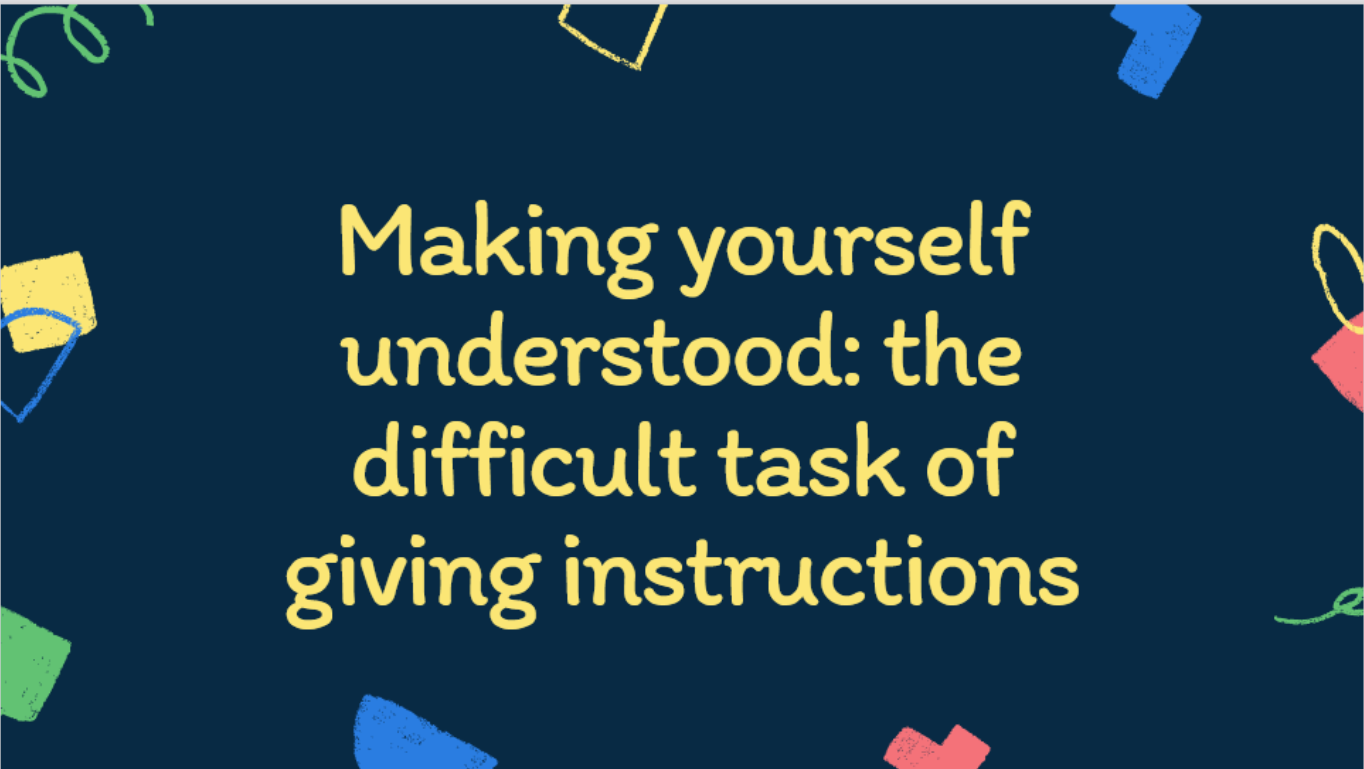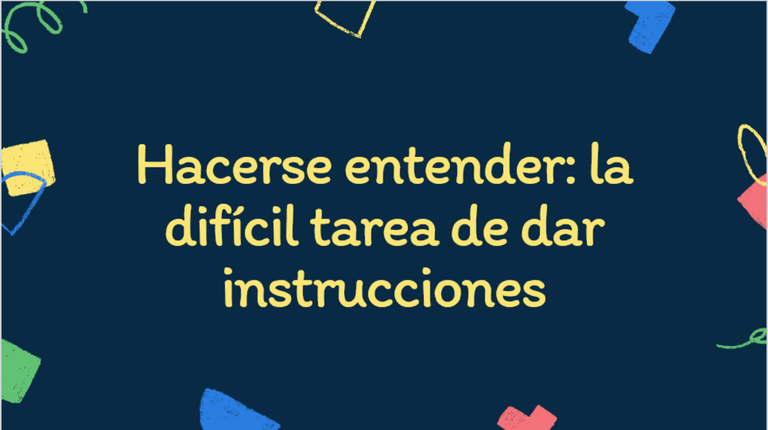
Image created in Canva
Let's see, let's see, how can I explain this to you! There is no more difficult task than making a person understand us and much more difficult than making a class group understand what we want them to do in any activity in class, don't you believe me? Let me tell you. A few days ago, a friend of mine was complaining about his students, because they did not understand the instructions he had given them in a written communication.
In that communication, he had written down, or at least he thought he had, that after each activity they should do a practical activity and hand in a piece of work, but that provision was called into question, because he did not define the type of work or the date of delivery. The result? the students ended up handing in whatever they wanted, by the means they considered appropriate and on the date they thought was best, and on the date they considered appropriate.
That ended in a tortuous session of reproaches from my dear friend during the class and a not very pleasant conversation with me when I remarked that one of the hardest things to do was to make our students understand us and that, unfortunately, in the written text there should be no room for semantic gaps. We revised the material, corrected and left more precise directions and even examples and weeks later, he told me that everything had improved a lot, although he still denies that he failed at the first attempt, I know that he recognises the importance of being as specific as possible when giving instructions.

From that day on, I understood that as a teacher I should not assume anything and be more precise, since it depends on that that my students understand what they have to do. To do this, I started by specifying the contents that had to be developed and explaining them so clearly that the students have as few doubts as possible, because it is necessary to remember that not everyone progresses at the same pace or with the same motivation. That is the first step: plan and organise the content well.

Then, provide activities as examples to familiarise students with the different ways in which instructions can be generated. This will make it easier later on for students to deal with any activity in the classroom. At the same time, try to promote communicative situations in which the students themselves are able to reflect on what is being asked of them with the intention of encouraging them to systematise the information. Rarely do you try to get students to reflect on their school activities, and this can be a valuable moment to promote this.
Finally, be attentive to details, to the students' reactions as they elaborate the tasks and how they take in the information. Paying attention to these details will allow us to evaluate each step we take on the subject and make ourselves understood in the classroom. In every area of our lives, trying to communicate better, that is, to make ourselves understood, is vital to promote a healthy relationship with our environment.
A hug, my loves.

Imagen creada en Canva.
¡A ver, a ver, cómo les explico esto! No hay tarea más difícil que hacer que una persona nos entienda y mucho más difícil que un grupo de clases comprenda lo que nosotros queremos que realicen ante cualquier actividad en clase ¿No me creen? Te cuento. Hace unos días un amigo se quejaba de sus estudiantes, porque no entendían las instrucciones que él les había dejado en una comunicación por escrito.
En esa comunicación, él dejaba por escrito o, al menos él así lo creía, que después de cada actividad debía hacerse una práctica y entregar un trabajo, pero,dicha disposición queda en entredicho, porque él no definía ni el tipo de trabajo ni la fecha de entrega. ¿Resultado? los estudiantes terminaron entregando lo que a bien ellos les parecía, por el medio en el que ellos consideraban oportuno y en la fecha que ellos estimaron.
Eso terminó en una tortuosa sesión de reproches por parte de mi estimado amigo durante la clase y una no muy grata conversación conmigo cuando le comenté que una de las cosas más difíciles de hacer era hacer que nuestros estudiantes nos entendieran y que, lamentablmente, en el texto escrito no debe haber cabida para los vacíos semánticos. Revisamos el material, corregimos y dejamos indicaciones más precisas e, incluso, ejemplos y semanas después, me contó que todo había mejorado muchísimo, aunque el sigue negando que falló en el primer intento, yo sé que reconoce la importancia de ser lo más específico al momento de girar instrucciones.

Como ese tengo un montón de ejemplos, experiencias que me han hecho reflexionar en torno a lo que ha sido mi práctica educativa en relación con las actividades propuestas en el aula. Recuerdo que hace mucho tiempo, en una de mis clases de lengua (la primera de ellas) les propocioné una lista de términos en la que debían reconocer la estructura de la sílaba y, luego, clasificar las palabras según su acento, pero para hacer eso, ellos debían separar en sílaba. Ese día quedé inconforme con el trabajo y se lo conté a una amiga y ella me dide: ¿Aja, tú les pediste que lo hicieran? Yo me quedé en silencio y le respondí que no y, en medio de mi soberbia profesoral, pues argumenté que ellos lo debían saber.
Desde ese día comprendí que como docente no debía suponer nada y ser más precisa, puesto que de eso depende que mis estudiantes comprendan lo que deben hacer. Para esto, comencé por precisar los contenidos que debían ser desarrollados explicarlos de forma tan clara que los etudiantes tengan la menor cantidad de dudas posibles, porque es necesario recordar que no todos avanzan al mismo ritmo ni con la misma motivación. Ese es el primer paso: planificar y organizar bien los contenidos.

Posteriormente,llevar actividades a manera de ejemplos que permitan familiarizar a los estudiates con las distintas formas que pudieran existir para generar instrucciones. Eso facilitará más adelante que los estudiantes aborden cualquier actividad dentro del salón de clases. Al mismo tiempo, intentar promover situaciones comunicativas en las que los mismos estudiantes sean capaces de reflexionar en torno a lo que se les está pidiendo con la intención de propiciar en ellos la sistematización de la información. Pocas veces, se busca hacer que los estudiantes reflexionen en torno a sus actividades escolares y ese momento puede ser valioso para promover eso.
Por último, mantenerse atento a los detalles, a la reacción de los estudiantes, mientras elaboran las tareas y cómo ellos asumen la información. Prestar atención a esos detalle, nos permitirá ir evaluando cada paso que damos sobre el tema hacernos entender dentro del salón de clases. En cada espacio de nuestras vidas, intetar comunicarnos mejor, es decir, hacernos entender es vital para promover una sana relación con nuestro entorno.
Un abrazo, mis amores.
That's one struggle of being a teacher. Every student has a different way of thinking. So better consider everyone. Especially those students that need guidance on everything that he does.
Yes, that is a reality we cannot ignore. The problem is that we forget it for a moment and do not stop to review our practice. I do not blame them. Teaching is a stressful, tiring and very poorly paid profession, at least in my country.
Regards, @mayt.
@tipu curate 6
Upvoted 👌 (Mana: 0/55) Liquid rewards.